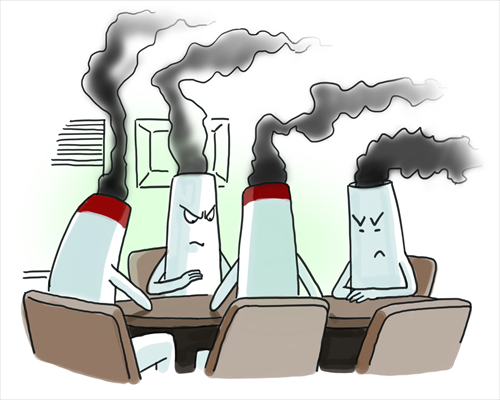 Top 100 beauties in the world!
Top 100 beauties in the world!
 Gallery: Who is the most beautiful one?
Gallery: Who is the most beautiful one?
 If you like autumn, put your hands in the air!
If you like autumn, put your hands in the air!
 Fan Bingbing's "Queen style" in new play
Fan Bingbing's "Queen style" in new play
 Lingerie show at 2014 Miss China
Lingerie show at 2014 Miss China
 J-10 fighters show aerobatic stunts in smog-free sky
J-10 fighters show aerobatic stunts in smog-free sky
 Charming contestants of Shanghai Int’l Model Contest
Charming contestants of Shanghai Int’l Model Contest
 Most amazing chi-pao beauties
Most amazing chi-pao beauties
 7 deadly animal attacks
Russia to launch 70 Proton rockets by 2020: official
7 deadly animal attacks
Russia to launch 70 Proton rockets by 2020: official |
| Illustration: Liu Rui/GT |
For a long time, international climate change negotiations have been marred by a lack of consensus on several fronts, particularly the emission reduction targets for individual countries. This stalemate has been partially overcome by the recent agreement reached by the US and China, which are responsible for 40 percent of the world's total greenhouse gas (GHG) emissions.
The agreement, signed by US President Barack Obama and Chinese President Xi Jinping, states that the US would reduce its emissions by 26 to 28 percent below 2005 levels, by 2025. China has agreed not only to cap emissions by 2030, but also to produce 20 percent of its energy using non-fossil fuels by the same year.
As far as the US is concerned, after years of criticism for not adopting any legally binding emission reduction targets, this step has come a year ahead of the crucial Paris climate summit in 2015, where the international community is hopeful of reaching an agreement to be enforced by 2020. This target is far beyond its previous target of cutting GHG emissions by 17 percent by 2020. However, the road ahead is not easy for Obama.
The Republicans were quick to slam the agreement. They claimed that this would give considerable leeway to China to emit as much as it wanted until 2030, while the US would have to resort to economically unviable measures to meet those steep targets.
On the contrary, China has in fact agreed to change its current course of growth in a much bigger way than anything the US is already doing, even though US emissions are already reportedly 10-15 percent below 2005 levels and falling by about 1.5 percent annually.
China, which has also been criticized since the Copenhagen summit in 2009 for blocking the international process, has decided to play the role of a responsible global player. For China, it is not just a question of international image, but also of fighting increasing pollution levels that have wracked socioeconomic havoc in its cities in the past few years.
Industrialized countries like Canada and Australia have always argued that until and unless the world's largest emitters took any concrete steps toward reducing emissions, neither would they. Now that this has happened, would they also join the bandwagon? Not really.
Even though both Australian Prime Minister Tony Abbott and Canadian Prime Minister Stephen Harper have welcomed the US-China climate agreement, it has been made amply clear by them that they don't want their continued economic growth to be hampered by emission reduction schemes. So much so that before the start of the G20 summit in Brisbane, Abbott even stated that the summit's focus should be on economic reforms rather than climate change.
Major developing economies like India and Brazil are now under pressure to raise their levels of commitment in the same vein as China. India and China have generally been on the same side of the climate negotiations' table and the US-China agreement clearly de-links them now.
India has yet to come up with an "intended" goal of cutting GHG emissions before the Paris summit. Former special envoy of the prime minister on climate change Shyam Saran has pointed out that if China had agreed to peak its emissions in 2030, then India could agree to do the same 15-20 years after 2030, taking into account India's aggregate and per capita emissions that are far lower than that of China.
The US-China climate agreement may not fully take into account the urgency of the issue. It has set only a low benchmark for the rest of the world to follow, but it nevertheless sets the tone for the make-or-break global climate negotiations at the Paris climate summit next year.
 Hot girls at motor show
Hot girls at motor show  Official trailer of Y-20
Official trailer of Y-20 Photos: Xi Jinping in Fujian
Photos: Xi Jinping in Fujian Standard faces for each countries
Standard faces for each countries China-made military transport aircraft gets ready
China-made military transport aircraft gets ready World Pole Dance Championship in China
World Pole Dance Championship in China Shocking! Photos of Chinese fighters revealed
Shocking! Photos of Chinese fighters revealed 59-year-old Liu Xiaoqing still looks stunning
59-year-old Liu Xiaoqing still looks stunning  In pics: PLA stages live-fire drill in NE China
In pics: PLA stages live-fire drill in NE China  Top 10 most dangerous jobs in the world
Top 10 most dangerous jobs in the world  Top 10 fifth generation jet fighters in the world
Top 10 fifth generation jet fighters in the world Top 10 Chinese goddesses
Top 10 Chinese goddesses  Top 20 hottest women in the world in 2014
Top 20 hottest women in the world in 2014 Top 10 pure beauties in showbiz
Top 10 pure beauties in showbiz  Top 10 world's highest-paid models 2014
Top 10 world's highest-paid models 2014 The most gorgeous Chinese women
The most gorgeous Chinese women Top 10 most handsome faces in Asia
Top 10 most handsome faces in AsiaDay|Week|Month